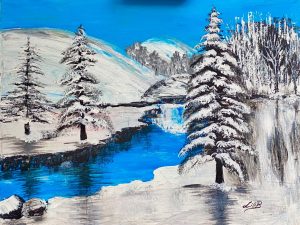This pastoral scene depicted in the painting showcases a traditional landscape narrative with a focus on an idyllic rural setting. The piece is notable for its vibrant presentation of autumnal hues and lush greens, reviving the bucolic charm reminiscent of mid-20th-century landscape works. The artist employs a technique indicative of impressionism combined with elements of realism, particularly observable in the textured brushwork used to represent the foliage and flowing water.
### Artistic Components
1. **Composition and Perspective**:
- The artwork employs a traditional perspective, directing the viewer's eye along the water stream leading to the quaint watermill. This not only provides depth but also enhances the painting’s narrative quality, suggesting a serene, ongoing rural life.
2. **Color and Texture**:
- The play of color is vibrant, with a strong juxtaposition of bright oranges, reds, and greens. This seasonal depiction adds to the artwork’s appeal, suggesting both vitality and decay — a dualism common in pastoral art.
- Texture, achieved through thick brushstrokes, adds a tactile quality to the trees and water, infusing the scene with a dynamic sense of movement and light.
3. **Scale and Detailing**:
- The scale focuses on the watermill as the central feature, framed by towering trees and an enveloping landscape. This gives a peaceful yet confined feeling, encapsulating a world within the canvas borders.
- Detailing in elements like the water wheel and windows of the house lend authenticity and charm, enhancing visual interest.
### Market Valuation and Fairness
- **Artist Recognition**:
If this artist is emerging with growing visibility in the art community, the pricing could reflect potential future value growth. For well-established artists, prices would inherently be higher due to proven market demand.
- **Material Quality**:
Assuming high-quality canvas and paints have been used, the artwork will maintain its integrity over time, which is a considerable factor in its valuation.
- **Comparative Market Analysis**:
Comparing this piece to the market for similar pastoral scenes, works that capture a similar nostalgic essence tend to range typically from $500 to $5,000, depending considerably on the artist's market position and the artwork’s size.
- **Intrinsic and Emotional Value**:
The scene's ability to evoke a sense of peace and nostalgia can significantly influence its emotional value to potential buyers, particularly those with a penchant for rustic and serene landscapes.
### Price Breakthrough Assessment
- **Technical Skill**:
The blending of colors and finesse in detail notably contribute to the pricing. These technical aspects might be priced within the context of $200 to $600, emphasizing the artist's competency in bringing a scene to life.
- **Emotional Appeal**:
The tranquility and warmth it may evoke could add approximately $300 to $800 to the price, reflecting the emotional connection that can be established with a prospective buyer.
- **Rarity and Theme**:
The idyllic theme, while popular, is rendered with a fresh perspective and palette that might add about $200 to $500 to its base value.
### Conclusion
For this painting, assuming a moderate level of recognition for the artist and high-quality execution, a fair market price would likely range between $1,200 and $3,500. This estimate considers both intrinsic qualities and market-driven factors, assuming the artwork is sold through a gallery or direct artist representation, which could influence the final price. If the painting were part of a larger series or exhibited in high-profile galleries, the higher end of the price spectrum could be justified.




